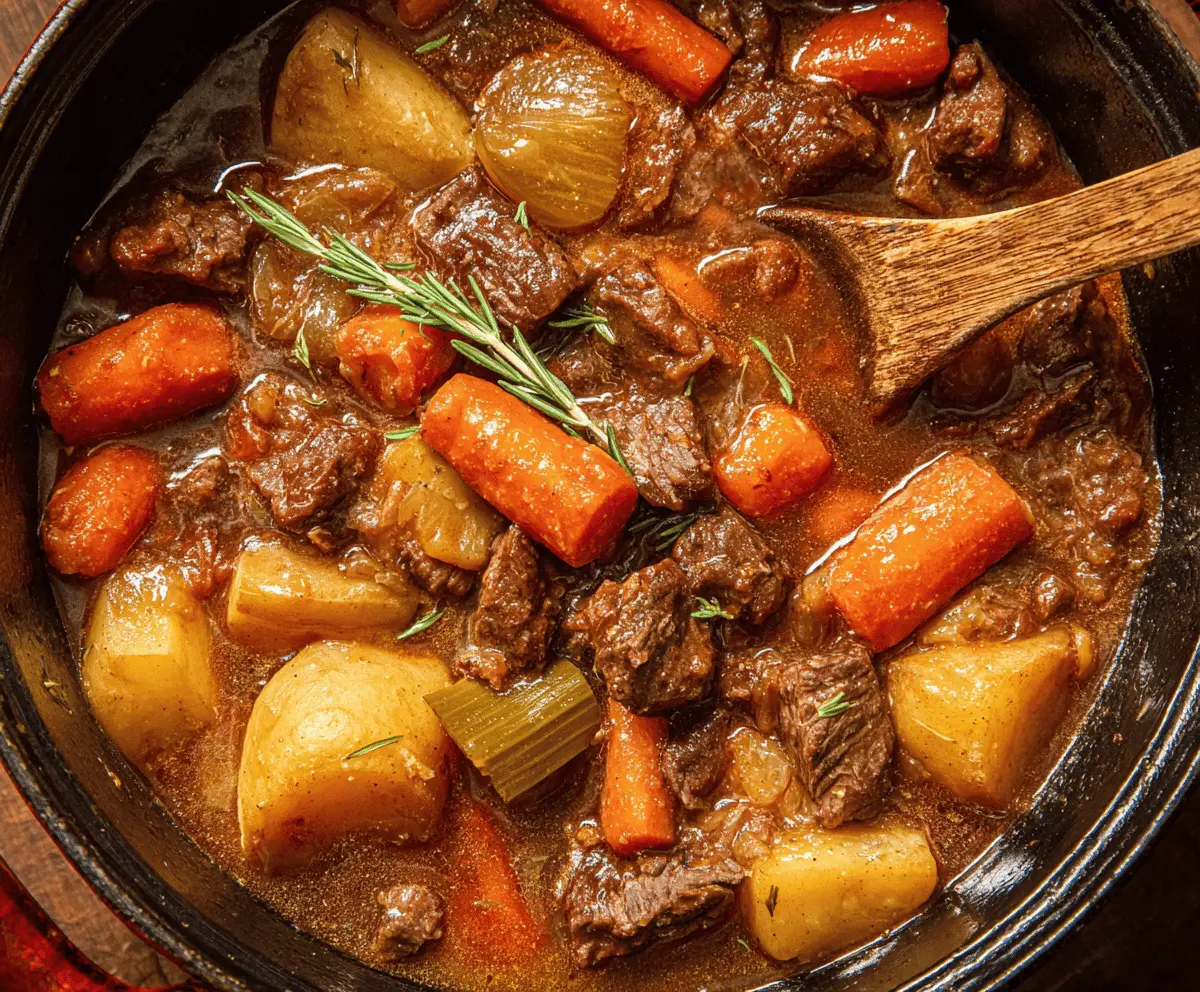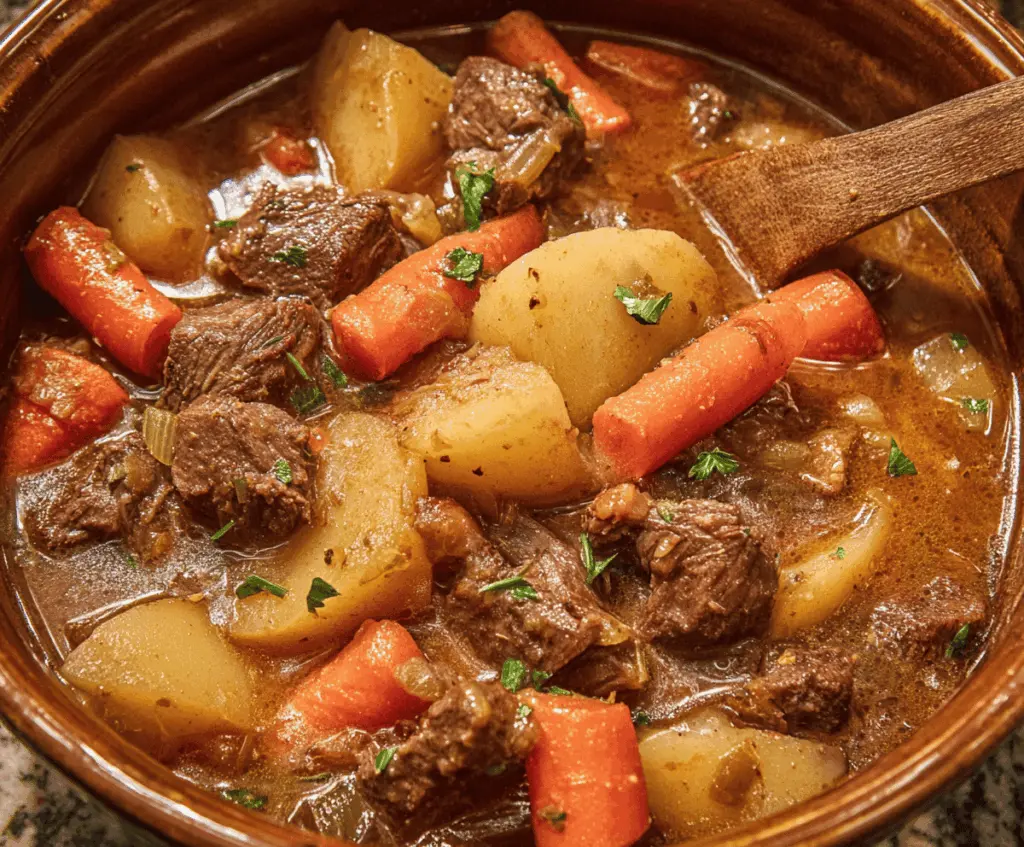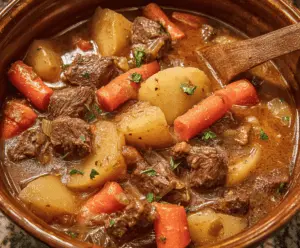Old Fashioned Beef Stew is a classic, hearty dish that’s full of tender chunks of beef, soft carrots, potatoes, and onions all simmered in a rich, flavorful broth. It’s the kind of meal that feels like a warm hug on a chilly day, with every bite comforting and satisfying.
I love making this stew when I want something simple but time-tested. There’s something special about slow-cooking the beef until it’s melt-in-your-mouth tender and letting all the veggies soak up those deep flavors. I usually make a big pot so there’s plenty to enjoy for leftovers, which somehow taste even better the next day.
When I serve this stew, I like to pair it with some crusty bread or a simple side salad. It’s perfect for family dinners or when friends come over and you want something that feels like home on a plate. Plus, it’s easy to customize with whatever root veggies you have on hand!
Key Ingredients & Substitutions
Beef Stew Meat: Chuck roast cut into cubes is great for this stew because it becomes tender and flavorful when slow-cooked. If you can’t find stew meat, ask your butcher for chuck or brisket cut into pieces.
Vegetables: Carrots, potatoes, and celery are classic choices. You can swap potatoes for sweet potatoes for a twist. Parsnips or turnips also add nice earthiness.
Broth & Tomato Paste: Use beef broth for a rich base, but beef stock or even vegetable broth works. Tomato paste adds depth—if you don’t have it, a spoonful of tomato sauce works too.
Herbs & Seasonings: Thyme, rosemary, and bay leaves bring classic aromas. Fresh herbs can replace dried if you have them—just add at the end to keep their bright flavor.
How Do I Get Tender, Flavorful Beef in My Stew?
Browning the beef before simmering is key. It locks in juices and builds flavor. Here’s how:
- Pat beef dry to avoid steaming.
- Heat oil in a heavy pot over medium-high heat.
- Brown meat in small batches, don’t overcrowd the pan.
- Let the beef develop a deep brown crust on all sides.
- Remove browned beef before cooking veggies to keep that rich taste.
After browning, slow simmer gently for 1.5-2 hours. This breaks down connective tissue and results in tender meat. Avoid boiling hard—you want a gentle bubble.

Equipment You’ll Need
- Large Dutch oven or heavy pot – I prefer this because it holds heat well and allows slow simmering for tender meat.
- Chef’s knife – makes chopping vegetables quick and easy.
- Cutting board – provides a clean space to prepare your ingredients.
- Measuring spoons and cups – for accurate seasoning and broth quantities.
- Stirring spoon – a wooden or silicone spoon is perfect for mixing and scraping the bottom.
- Skimmer or slotted spoon – helpful for removing excess fat or pieces during cooking.
Flavor Variations & Add-Ins
- Swap beef for lamb or chicken, cooking them until tender for different flavors. Lamb adds richness, chicken keeps it lighter.
- Stir in a splash of red wine or balsamic vinegar during cooking for added depth.
- Add in mushrooms or peas in the last 15 minutes for extra texture and freshness.
- Use fresh herbs like parsley or thyme instead of dried for a brighter, more vibrant taste.
Old Fashioned Beef Stew
Ingredients You’ll Need:
- 2 lbs beef stew meat, cut into 1-inch cubes
- 3 tbsp vegetable oil
- 1 large onion, chopped
- 4 cloves garlic, minced
- 4 cups beef broth
- 1 cup water
- 3 large carrots, peeled and cut into chunks
- 4 medium potatoes, peeled and cut into chunks
- 2 stalks celery, sliced
- 2 tbsp tomato paste
- 1 tsp dried thyme
- 1 tsp dried rosemary
- 2 bay leaves
- Salt and black pepper, to taste
- 3 tbsp all-purpose flour (optional, for thickening)
- 2 tbsp fresh parsley, chopped (for garnish)
How Much Time Will You Need?
This recipe takes about 20 minutes of prep and browning, plus 2 to 2.5 hours of simmering time. The slow cooking is what makes the beef tender and the flavors rich, so be patient and enjoy the cooking process.
Step-by-Step Instructions:
1. Brown the Beef:
Heat the vegetable oil in a large heavy pot or Dutch oven over medium-high heat. Add the beef cubes in batches, spreading them out so they brown well on all sides. This step adds lots of flavor! Remove the browned beef and set it aside.
2. Cook the Aromatics:
In the same pot, add the chopped onion and cook for about 5 minutes until soft and see-through. Stir in the minced garlic and cook for another minute until fragrant.
3. Add Tomato Paste & Deglaze:
Stir in the tomato paste and cook for 2 minutes to deepen the flavor. Pour in the beef broth and water, using a spoon to scrape up those tasty browned bits from the bottom of the pot.
4. Simmer the Beef:
Return the browned beef to the pot. Add thyme, rosemary, bay leaves, salt, and pepper. Bring everything to a boil, then reduce the heat to low. Cover and simmer gently for 1.5 to 2 hours, until the beef is tender.
5. Add Vegetables:
Add the carrots, potatoes, and celery. Cover again and continue to simmer for 30 to 40 minutes, or until the vegetables are tender.
6. Thicken the Stew (Optional):
If you’d like a thicker stew, mix the flour with a small amount of cold water to make a smooth slurry. Stir this into the stew, and cook for 5 more minutes until the broth thickens.
7. Final Touches:
Remove the bay leaves. Taste the stew and add more salt or pepper if needed. Sprinkle chopped fresh parsley over the top just before serving for a fresh burst of flavor.
Serve your Old Fashioned Beef Stew hot, ideally with warm crusty bread to soak up the delicious broth. Enjoy!
Can I Use Frozen Beef Stew Meat?
Yes, you can use frozen beef stew meat, but make sure to thaw it completely in the refrigerator overnight before cooking. This helps the beef brown properly and ensures even cooking.
How Can I Make This Stew Ahead of Time?
This stew tastes even better the next day! Prepare it fully, then cool to room temperature and store in an airtight container in the fridge for up to 3 days. Reheat gently on the stove over low heat.
What’s the Best Way to Store Leftovers?
Store leftover stew in an airtight container in the fridge for 3 to 4 days. You can also freeze it for up to 3 months—just thaw overnight in the fridge before reheating.
Can I Substitute Vegetables in the Stew?
Absolutely! Feel free to add root vegetables like parsnips or turnips, or swap potatoes for sweet potatoes. Just add firmer veggies earlier to ensure they cook through.



